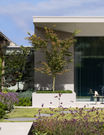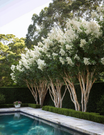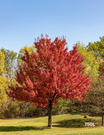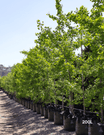When designing a garden, many factors come into play—beauty, size, seasonal interest—but one important consideration often overlooked is allergen control. If you or your family members are prone to seasonal allergies, carefully selecting the right trees for your garden can significantly reduce allergy triggers. Choosing low-allergen trees doesn’t mean sacrificing elegance or appeal; in fact, there are stunning options that enhance your landscape's aesthetic and create a more breathable outdoor environment.
In this guide, we’ll explore three exceptional trees that are less likely to aggravate allergies: Ginkgo biloba (Maidenhair Tree), Malus floribunda (Japanese Crabapple), and Pistacia chinensis (Chinese Pistache). These trees are breathtakingly beautiful and well-suited for low-allergen garden designs.
The Importance of Selecting Low-Allergen Trees
Many trees release pollen, which is a common trigger for allergies. Choosing species with low pollen production or pollen that is less likely to become airborne can make a big difference. Additionally, dioecious trees—meaning they have separate male and female plants—allow you to plant only the female trees, which produce no pollen.
Let’s explore these three outstanding tree options for your low-allergen garden.
Ginkgo biloba (Maidenhair Tree)
The Ginkgo biloba, often called the Maidenhair Tree, is a tree of distinction. Its fan-shaped leaves, turning a striking golden yellow in autumn, make it a stunning feature in any landscape. What sets this tree apart is its minimal impact on allergy sufferers. Since only the male Ginkgo produces pollen, choosing female trees eliminates the pollen risk.
Key Facts
- Mature Height: 15-25 meters
- Mature Width: 8-10 meters
- Best Uses: Feature tree, street tree, shade tree
- Leaf Appearance: Distinctive, fan-shaped leaves that turn bright yellow in autumn
- Rate of Growth: Slow to medium
- Tolerates: Urban pollution, heat, poor soils, drought
Why Ginkgo Biloba is Perfect for a Low-Allergen Garden
The Ginkgo biloba is well-suited for those seeking a low-maintenance, allergy-friendly tree. Its ability to thrive in urban environments while resisting pests and disease makes it an ideal addition to luxury gardens. Additionally, the absence of problematic pollen—when female trees are planted—ensures that this elegant tree won't trigger allergies, allowing you to enjoy its striking beauty year-round.

Incorporating the Ginkgo biloba into your garden will provide structure and form, especially as a standout feature tree. Its brilliant autumn display is enough to captivate anyone who steps into your garden, all while maintaining an allergy-free environment.
Malus floribunda (Japanese Crabapple)
Malus floribunda, the Japanese Crabapple, is an exceptional choice for those who seek a burst of spring color without the sneezing fits. Known for its vibrant display of pink and white blossoms, this tree is low in pollen and attracts beneficial pollinators, adding a lively buzz to your garden without impacting allergy sufferers.
Key Facts
- Mature Height: 4-8 meters
- Mature Width: 5-6 meters
- Best Uses: Feature tree, ornamental tree, small spaces
- Leaf Appearance: Dark green, turning yellow in autumn
- Rate of Growth: Medium
- Tolerates: Cold climates, various soil types, urban environments
Why Malus floribunda is Perfect for a Low-Allergen Garden
Malus floribunda produces large, showy blooms that are sure to turn heads. However, unlike many other flowering trees, its lower pollen production makes it less likely to irritate allergies. Its compact size makes it perfect for smaller gardens, courtyard spaces, or as an ornamental feature in larger landscapes. Furthermore, it’s a versatile tree that tolerates colder climates and urban pollution.
Incorporating Malus floribunda into your garden adds seasonal color and encourages a healthy ecosystem. Birds love the small fruits that appear in late summer, enhancing the biodiversity of your space without the worry of allergies.
Pistacia chinensis (Chinese Pistache)
If you’re searching for a tree that offers rich autumn color, is hardy, and won't trigger allergies, look no further than the Pistacia chinensis. The Chinese Pistache is known for its fiery orange and red foliage in autumn, making it a standout in any garden. Its pollen is heavy and sticky, meaning it’s less likely to become airborne and trigger allergies.
Key Facts
- Mature Height: 8-12 meters
- Mature Width: 6-8 meters
- Best Uses: Feature tree, shade tree, drought-tolerant gardens
- Leaf Appearance: Pinnate, dark green turning bright red in autumn
- Rate of Growth: Medium to fast
- Tolerates: Drought, poor soil, heat, and wind
Why Pistacia chinensis is Perfect for a Low-Allergen Garden
The Pistacia chinensis is an all-rounder. It’s drought-tolerant, making it perfect for water-conscious landscapes, and its vibrant foliage creates a beautiful contrast during autumn months. More importantly, its pollen is not as airborne, which makes it an excellent choice for those looking to reduce allergy triggers in their garden.
This tree’s robust nature means it’s well-suited for areas with less-than-ideal soil or weather conditions, ensuring it thrives with minimal intervention. Adding the Pistacia chinensis to your garden will not only provide an explosion of autumn color but also help maintain an allergy-friendly space.
Planting Tips for a Low-Allergen Garden
When planting trees in a low-allergen garden, consider the following tips:
- Choose Dioecious Trees: Opt for female plants whenever possible, as they do not produce pollen.
- Keep Trees Well Pruned: Regular pruning helps maintain the health of your trees and prevents overproduction of pollen in species that do produce some.
- Select Native Species: Native trees require less maintenance and often produce less pollen than exotic species.
Best Practices for Tree Planting:
- Location is Key: Ensure your trees are planted in well-drained soil and consider their mature size when choosing a location.
- Amend the Soil: If soil is compacted or lacks nutrients, amend it with organic matter to ensure healthy growth.
- Watering Needs: While trees like Pistacia chinensis are drought-tolerant, others may require regular watering, especially during establishment.
- Tease the Roots: When planting, gently tease the roots to encourage outward growth and prevent them from becoming root-bound.
- Mulch: Use mulch around the tree's base to retain moisture and reduce weeds.
FAQs
Which trees are best for reducing allergens in my garden?
Trees like Ginkgo biloba, Malus floribunda, and Pistacia chinensis are excellent choices for low-allergen gardens due to their minimal pollen production.
How can I prevent pollen from affecting my garden?
Plant female trees when possible, prune trees regularly to prevent excessive pollen and consider planting in areas less prone to wind.
Are these trees suitable for urban gardens?
Yes, all three trees—Ginkgo biloba, Malus floribunda, and Pistacia chinensis—are well-suited for urban environments due to their pollution tolerance and compact growth habits.
By selecting the right trees for your garden, you can enjoy the beauty and benefits of a thriving outdoor space without the concern of allergies. The trees we've covered—Ginkgo biloba, Malus floribunda, and Pistacia chinensis—combine elegance with practicality, making them ideal choices for any high-end, low-allergen garden.








































Leave a comment
This site is protected by hCaptcha and the hCaptcha Privacy Policy and Terms of Service apply.